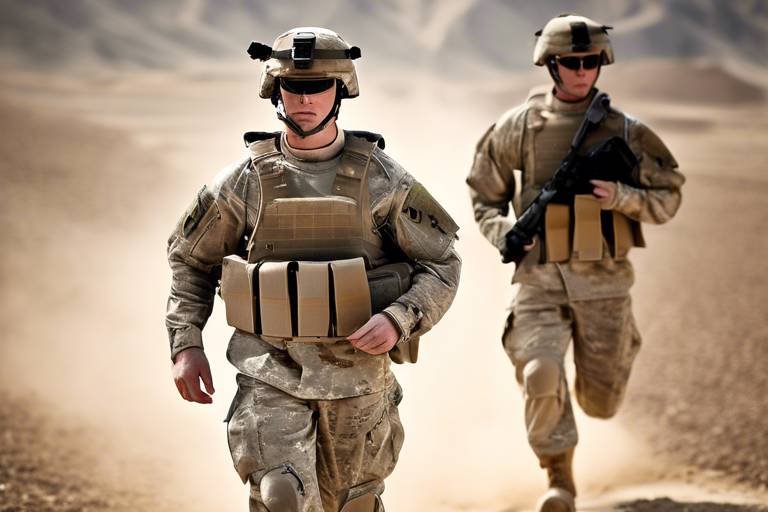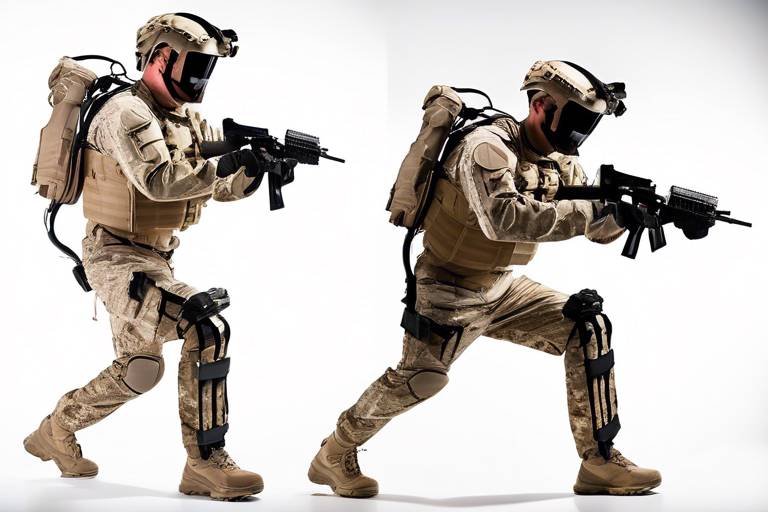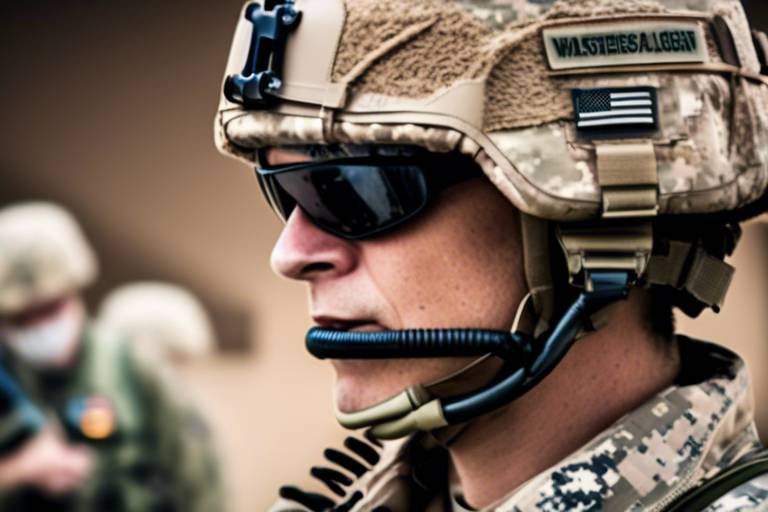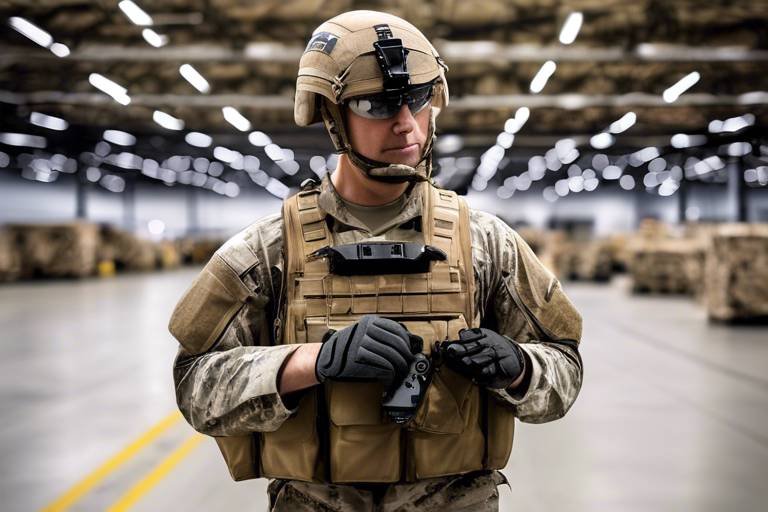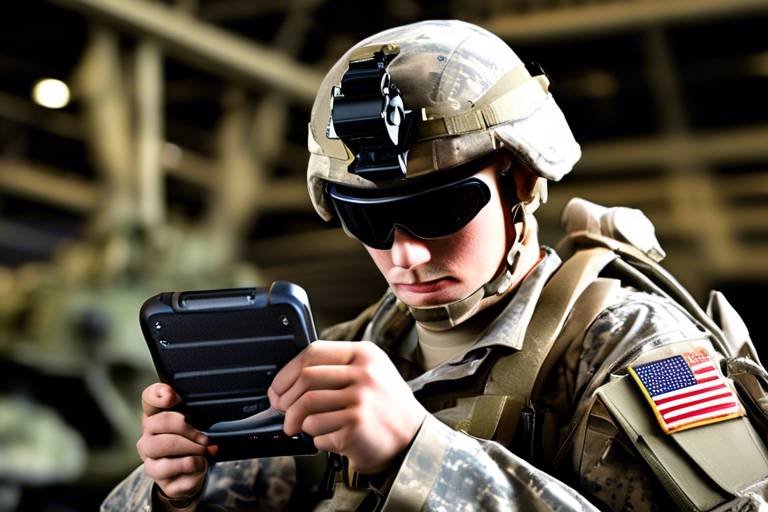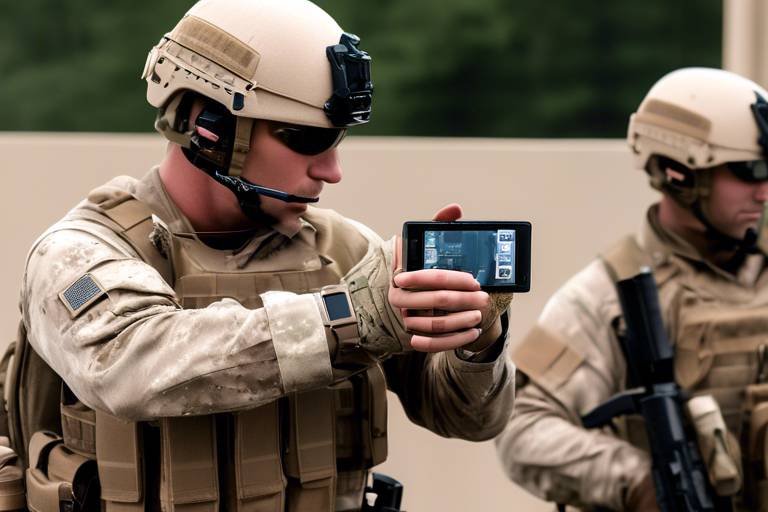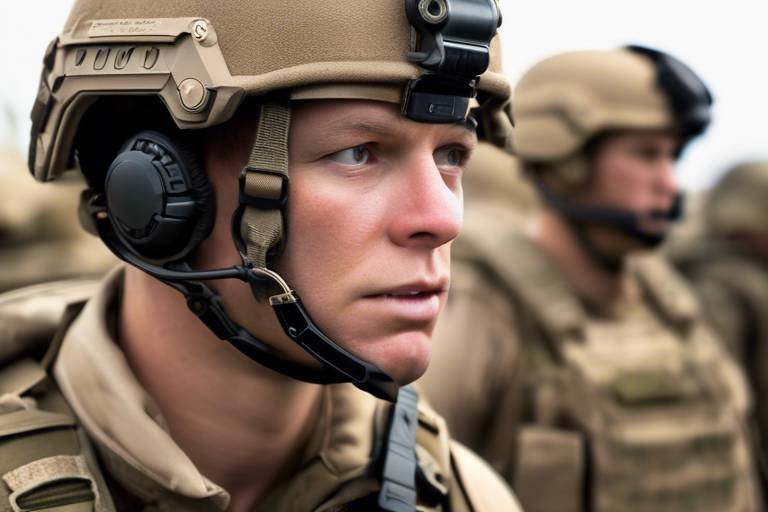The Role of Wearable Technologies in Enhancing Soldier Performance Metrics
In the modern battlefield, where every second counts and every decision can mean the difference between success and failure, wearable technologies are emerging as game-changers. These innovative devices are not just fancy gadgets; they are transforming how soldiers operate by providing critical insights into their performance metrics. Imagine a soldier on a mission, equipped with a device that continuously tracks their heart rate, hydration levels, and even stress indicators. This data is not merely collected; it is analyzed in real-time, allowing for immediate adjustments to enhance performance. The integration of such technologies means that soldiers can push their limits while ensuring their health and safety are prioritized.
Wearable technologies are revolutionizing military operations in several ways. First, they facilitate real-time data collection, which is essential for understanding a soldier's physical and mental state during missions. This capability allows commanders to make informed decisions based on precise metrics rather than relying solely on instinct or outdated methods. Furthermore, the feedback mechanisms embedded in these devices empower soldiers to take charge of their own health and performance, creating a culture of self-awareness and proactive management.
As we delve deeper into this topic, it's essential to recognize the variety of wearable devices available today. From fitness trackers that monitor physical activity to smart clothing embedded with sensors, each technology serves a unique purpose in enhancing soldier performance. For instance, fitness trackers can help soldiers maintain optimal fitness levels by tracking their exercise routines and sleep patterns, while smart clothing can provide real-time feedback on vital signs and body movements, ensuring that soldiers remain comfortable and effective in the field.
Moreover, the role of biometric sensors cannot be understated. These devices measure physiological indicators such as stress levels and hydration, which are crucial for maintaining soldier readiness. By keeping an eye on these metrics, military leaders can intervene before fatigue sets in, thereby improving overall mission success rates. In essence, wearable technologies are not just improving performance metrics; they are actively contributing to the health and safety of soldiers, making them invaluable assets on the battlefield.
In summary, the role of wearable technologies in enhancing soldier performance metrics is multifaceted and profound. They provide real-time insights, promote self-awareness, and ensure that soldiers are prepared both physically and mentally for the challenges they face. As these technologies continue to evolve, we can only anticipate even greater advancements that will further empower our military personnel.
- What types of wearable technologies are used in the military?
Wearable technologies in the military include fitness trackers, smart clothing, and biometric sensors, each designed to monitor various aspects of soldier performance and health.
- How do wearable technologies improve soldier health and safety?
These devices provide continuous monitoring and alerts for potential health risks, allowing for timely interventions that reduce injury and enhance overall well-being.
- What challenges do wearable technologies face in military applications?
Challenges include data privacy concerns, device reliability, and the need for comprehensive training to effectively utilize these technologies in the field.
- What is the future of wearable technologies in the military?
The future is promising, with advancements in AI and machine learning expected to further enhance soldier performance metrics and operational efficiency.
Introduction to Wearable Technologies
Wearable technologies are transforming the landscape of military operations, providing a new dimension to how soldiers monitor their health and performance. These devices are not just gadgets; they are sophisticated tools that collect and analyze data in real-time, giving soldiers critical insights into their physiological state and environmental conditions. Imagine having a personal coach that never sleeps, constantly analyzing your heart rate, activity levels, and even your stress responses. That's precisely what these technologies offer!
At their core, wearable technologies encompass a variety of devices designed to enhance soldier performance by tracking a range of physiological and environmental parameters. From fitness trackers that monitor physical activity to smart clothing embedded with sensors, these devices are engineered to provide actionable feedback that can make a significant difference in mission readiness. The ability to continuously collect data means that soldiers can receive real-time updates about their health, which is crucial during high-stakes operations.
Furthermore, the integration of these technologies into military settings opens up a world of possibilities. Soldiers can gain insights into their performance metrics, such as endurance and recovery times, which are essential for optimizing training regimens. The feedback loop created by these devices allows for immediate adjustments, ensuring that soldiers are always in peak condition. For instance, if a soldier's heart rate spikes during a training exercise, the wearable device can alert them to slow down, preventing potential health risks before they escalate.
In addition to monitoring physical health, wearable technologies also focus on environmental factors. For example, devices can track weather conditions, altitude, and even the soldier's hydration levels. This comprehensive approach ensures that soldiers are not only fit but also adequately prepared for the challenges they face in the field. The data collected can be invaluable for military leaders, providing insights that help in strategizing missions and ensuring that soldiers are equipped to handle the rigors of their tasks.
Overall, wearable technologies are revolutionizing how the military views soldier performance and health. As we delve deeper into the various types of wearable devices and their applications, it becomes evident that these innovations are not just enhancing performance metrics but are also paving the way for a healthier, more efficient military force.
Types of Wearable Devices
When it comes to the military, the adoption of wearable technologies is not just a trend; it's a transformative approach that is reshaping how soldiers operate on the field. These devices come in various forms, each tailored to meet the unique demands of military environments. Imagine a soldier equipped with a fitness tracker, smart clothing, or biometric sensors—each one playing a crucial role in enhancing performance and safety. Let's dive deeper into these types of wearable devices and how they contribute to soldier effectiveness.
Fitness trackers are perhaps the most recognized type of wearable technology. These devices go beyond merely counting steps; they monitor physical activity levels, heart rates, and even sleep patterns. For soldiers, maintaining peak physical condition is vital, especially during rigorous training and operational deployments. By providing real-time data, fitness trackers help soldiers adjust their routines to optimize performance. Imagine a soldier who can instantly see how their heart rate responds to stress during a mission. This immediate feedback can be the difference between success and failure.
Next up is smart clothing, which integrates sensors directly into the fabric. This innovative approach allows for the tracking of vital signs and body movements without hindering the soldier's mobility. Picture a uniform that not only shields against environmental hazards but also monitors the wearer's physiological state. This level of integration enhances both comfort and performance. Real-time feedback from smart clothing can be invaluable for soldiers and their commanders, providing insights that lead to strategic adjustments on the fly. Just think about how much more effective a unit can be when they have access to immediate health data during a mission!
Lastly, we have biometric sensors, which are designed to measure various physiological indicators such as stress levels and hydration status. These sensors can alert soldiers and their leaders to potential health issues before they escalate into serious problems. For instance, if a soldier is becoming overly stressed or dehydrated, the system can prompt interventions that ensure they remain mission-ready. This proactive approach not only enhances individual performance but also contributes to the overall effectiveness of the unit. In high-stakes environments, these timely alerts can be lifesaving.
In summary, the landscape of wearable technologies in the military is rich with possibilities. Each device, whether it's a fitness tracker, smart clothing, or biometric sensor, serves a specific purpose that collectively enhances soldier performance metrics. As these technologies continue to evolve, we can expect even more innovative solutions that will redefine how soldiers prepare for and execute their missions.
Fitness Trackers
Fitness trackers have emerged as a game-changing technology in the military, revolutionizing how soldiers monitor their physical well-being and performance. These devices, often worn on the wrist, are equipped with advanced sensors that track a myriad of metrics, from heart rate to sleep patterns. Imagine having a personal coach that never sleeps, constantly providing feedback on your body's condition, and that’s precisely what fitness trackers do for soldiers in the field.
By continuously monitoring physical activity levels, fitness trackers help soldiers maintain optimal fitness during rigorous training and operational deployments. They serve as an early warning system, alerting users when their heart rates spike or when they are not getting enough rest. This is crucial because, in military operations, every second counts, and being in peak physical condition can mean the difference between mission success and failure.
Moreover, these devices can be integrated with mobile applications that allow soldiers to review their performance data over time. This integration creates a comprehensive overview of their physical health, enabling them to make informed decisions about their training regimens. For instance, if a soldier notices a consistent drop in their activity levels, they can adjust their training to address potential fatigue or health issues before they escalate.
Here’s a quick look at some of the key features of fitness trackers in military applications:
- Heart Rate Monitoring: Provides real-time data to help soldiers understand their cardiovascular health.
- Activity Tracking: Monitors daily movements and workouts, encouraging soldiers to stay active.
- Sleep Analysis: Tracks sleep quality, ensuring soldiers get adequate rest for optimal performance.
- GPS Functionality: Allows for tracking of distance covered during training runs or missions.
In addition to these features, fitness trackers can also be linked to larger military health monitoring systems. This connection allows commanders to access aggregated data, giving them insights into the overall health and readiness of their troops. It’s like having a digital health dashboard that provides a snapshot of soldier wellness, which is invaluable for making strategic decisions about deployments and resource allocation.
However, the benefits of fitness trackers extend beyond mere data collection. They also promote a culture of health and wellness within the military. Soldiers become more aware of their physical condition and are encouraged to take proactive measures to improve it. This shift in mindset can lead to enhanced morale and camaraderie among troops, as they collectively strive for better health and performance.
In conclusion, fitness trackers are not just gadgets; they are essential tools that contribute to the overall effectiveness of military operations. By providing real-time feedback and fostering a culture of health, these devices empower soldiers to perform at their best while ensuring their safety and well-being. As technology continues to evolve, we can only imagine the further enhancements that will come to wearable fitness technology, paving the way for a new era of military readiness.
Q1: How do fitness trackers help in military training?
A1: Fitness trackers monitor various metrics such as heart rate, activity levels, and sleep patterns, enabling soldiers to optimize their training regimens and maintain peak physical condition.
Q2: Are fitness trackers reliable in extreme conditions?
A2: Most fitness trackers are designed to withstand harsh environments, but reliability can vary by model. It's essential to choose devices specifically rated for military use.
Q3: Can data from fitness trackers be shared with commanders?
A3: Yes, many fitness trackers can sync with military health monitoring systems, allowing commanders to access aggregated data for better decision-making regarding troop readiness.
Smart Clothing
Imagine slipping into a uniform that not only fits like a glove but also keeps tabs on your body’s vital signs. is at the forefront of merging fashion with technology, especially in the military realm. These innovative garments are embedded with sensors that track a soldier's physiological data in real-time. From monitoring heart rates to analyzing body movements, smart clothing is designed to enhance performance while ensuring comfort.
One of the most exciting aspects of smart clothing is its ability to provide immediate feedback. For instance, if a soldier is pushing their limits during a training exercise, the embedded sensors can detect changes in heart rate or muscle strain. This data is relayed to both the soldier and their commanding officers, allowing for quick adjustments to training regimens or operational strategies. It’s like having a personal coach right on your body, guiding you to optimal performance.
Furthermore, smart clothing can significantly improve the overall experience of soldiers on the field. Traditional military gear can often be bulky and restrictive, but with advancements in fabric technology, smart clothing offers a more streamlined and comfortable fit. This not only boosts morale but also enhances mobility—crucial during high-stakes missions. Imagine a soldier wearing a lightweight shirt that can monitor their hydration levels; if they’re getting dehydrated, the shirt can alert them to drink water before it becomes a serious issue.
In addition to health monitoring, smart clothing can also play a role in environmental awareness. For example, some garments are equipped with sensors that can detect changes in temperature or humidity. This information can be vital for soldiers operating in extreme conditions, helping them to adapt their strategies accordingly. The integration of these technologies means that soldiers are not just equipped with weapons, but also with the knowledge of their own bodies and surroundings.
However, the implementation of smart clothing is not without its challenges. Issues like durability, battery life, and data accuracy need to be addressed to ensure these technologies can withstand the rigors of military operations. Yet, with ongoing research and development, the future looks bright for smart clothing in the military sector.
In summary, smart clothing represents a leap forward in how we can support our soldiers. By combining advanced technology with practical applications, these garments not only enhance performance but also contribute to the health and safety of military personnel. As we continue to innovate in this space, the potential for smart clothing to revolutionize military operations is enormous.
- What is smart clothing? Smart clothing refers to garments that have embedded sensors to monitor physiological data and provide real-time feedback on performance and health.
- How does smart clothing benefit soldiers? It enhances performance by providing immediate feedback, improving comfort, and monitoring health metrics such as heart rate and hydration levels.
- Are there any challenges with smart clothing? Yes, challenges include durability, battery life, and ensuring data accuracy in various conditions.
- What advancements are expected in smart clothing? Future advancements may include improved sensor technology, better fabric materials, and enhanced data analytics capabilities.
Biometric Sensors
Biometric sensors are at the forefront of enhancing soldier performance by providing critical insights into their physiological state. These devices are designed to measure a variety of indicators, such as heart rate, stress levels, hydration status, and even fatigue. Imagine having a personal health assistant strapped to your body, constantly monitoring your well-being and alerting you to any potential issues. This is the reality for many soldiers today, thanks to the advent of biometric technology.
One of the most significant advantages of biometric sensors is their ability to deliver real-time data. For instance, during intense physical activity or combat situations, these sensors can track how a soldier's body is responding. If a soldier's heart rate spikes or if they show signs of dehydration, the sensor can send immediate alerts to both the soldier and their commanding officers. This capability allows for timely interventions, which can be the difference between mission success and failure.
Moreover, biometric sensors can also contribute to long-term health monitoring. By collecting data over time, these devices can help identify patterns in a soldier's health and performance. For example, if a soldier consistently shows elevated stress levels during specific training exercises, military leaders can adjust their training regimens or provide additional support. This proactive approach not only enhances individual performance but also contributes to the overall readiness of military units.
To illustrate the various functions of biometric sensors, consider the following table that summarizes their key features and benefits:
| Feature | Benefit |
|---|---|
| Heart Rate Monitoring | Identifies cardiovascular strain and helps in managing exertion levels. |
| Stress Level Assessment | Alerts soldiers to mental fatigue, allowing for timely breaks and recovery. |
| Hydration Tracking | Prevents dehydration, which is critical for maintaining physical performance. |
| Fatigue Detection | Helps in preventing overexertion and potential injuries during training. |
In conclusion, biometric sensors are more than just gadgets; they are essential tools that empower soldiers to optimize their performance and ensure their safety on the battlefield. By providing critical data in real-time, these devices help military personnel make informed decisions about their health and readiness, ultimately enhancing mission effectiveness. As technology continues to evolve, we can expect even more sophisticated biometric solutions that will further revolutionize how soldiers monitor their health and performance.
- What are biometric sensors? Biometric sensors are devices that measure physiological indicators such as heart rate, stress levels, and hydration status, providing real-time health monitoring.
- How do biometric sensors help soldiers? They enhance soldier performance by offering insights into physical and mental health, allowing for timely interventions and adjustments to training or operational strategies.
- Are biometric sensors reliable? While generally reliable, the effectiveness of biometric sensors can depend on factors like device quality and the environment in which they are used.
- Can biometric sensors prevent injuries? Yes, by monitoring fatigue and stress levels, these sensors can alert soldiers to take necessary breaks and avoid overexertion.
- What is the future of biometric sensors in the military? Advancements in technology are expected to lead to more sophisticated and integrated biometric solutions that will further enhance soldier performance and safety.
Data Analytics in Military Wearables
In today’s fast-paced military environment, the integration of data analytics into wearable technologies is nothing short of revolutionary. Imagine a scenario where every heartbeat, every step, and every ounce of sweat is meticulously recorded and analyzed to enhance a soldier's performance. This is not science fiction; it’s the reality of modern warfare. Wearable devices equipped with advanced sensors collect a plethora of data, and through sophisticated analytics, this information transforms into actionable insights that can significantly improve operational effectiveness.
One of the most compelling aspects of data analytics in military wearables is the concept of real-time monitoring. With the ability to track metrics such as heart rate, body temperature, and even stress levels, commanders can make immediate adjustments to training regimens and operational strategies. For instance, if a soldier's heart rate spikes significantly during a mission, it could indicate excessive stress or fatigue. Commanders can then decide whether to pull that soldier from the field or provide additional support, ensuring that every team member is performing at their peak.
Moreover, the use of predictive analytics adds another layer of sophistication to military operations. By analyzing historical data trends, these systems can forecast potential health issues or performance declines. For example, if a soldier consistently shows signs of dehydration during training, predictive models can alert commanders to intervene proactively. This not only enhances individual soldier health but also ensures that the entire unit remains mission-ready. The table below illustrates some key metrics that can be monitored and analyzed through wearable technologies:
| Metric | Description | Importance |
|---|---|---|
| Heart Rate | Monitors cardiovascular exertion | Indicates stress levels and fatigue |
| Body Temperature | Tracks thermal stress | Prevents heat-related illnesses |
| Sleep Patterns | Analyzes recovery and rest | Enhances overall performance |
| Hydration Levels | Measures fluid intake and loss | Prevents dehydration and fatigue |
The significance of these metrics cannot be overstated. By leveraging data analytics, military leaders can make informed decisions that not only enhance individual performance but also improve the effectiveness of the entire unit. The ability to monitor and analyze performance in real time is akin to having a coach in the field, guiding soldiers to achieve their best.
However, the journey doesn’t end here. As technology continues to evolve, we can expect even more sophisticated data analytics capabilities in military wearables. Imagine AI systems that can learn from soldiers' performance patterns and provide personalized feedback, ensuring that each soldier receives tailored support based on their unique needs. The future of military operations is bright, and data analytics will undoubtedly play a central role in shaping it.
- What types of data do military wearables collect? Military wearables can collect a variety of data, including heart rate, body temperature, sleep patterns, and hydration levels.
- How does real-time monitoring benefit soldiers? Real-time monitoring allows for immediate adjustments to training and operational strategies, enhancing soldier performance and safety.
- What is predictive analytics in military wearables? Predictive analytics uses historical data to forecast potential health issues or performance declines, enabling proactive interventions.
- Are there any privacy concerns with military wearables? Yes, data privacy is a significant concern, and measures must be taken to ensure that sensitive information is protected.
Real-Time Monitoring
Imagine being in a high-stakes environment where every second counts. through wearable technologies has transformed how soldiers operate in the field, providing them with immediate access to vital performance metrics. These advanced devices continuously collect data on various physiological parameters, such as heart rate, body temperature, and even stress levels, enabling soldiers and their commanders to make informed decisions on the fly.
For instance, during a mission, if a soldier's heart rate spikes beyond a predetermined threshold, the wearable device can instantly alert both the soldier and their team leader. This instantaneous feedback is crucial for ensuring that soldiers can adjust their exertion levels accordingly, preventing potential health issues before they escalate. The beauty of real-time monitoring lies in its ability to provide actionable insights at the moment they are needed most.
Furthermore, this technology doesn't just enhance individual performance; it also fosters teamwork. Commanders can monitor the health and readiness of their entire unit, allowing for strategic adjustments based on collective data. For example, if multiple soldiers show signs of fatigue, a commander can decide to alter the mission plan, ensuring that the team remains effective and safe. This proactive approach is a game-changer in military operations.
To illustrate the impact of real-time monitoring, consider the following table that summarizes key benefits:
| Benefit | Description |
|---|---|
| Immediate Feedback | Allows soldiers to adjust their performance based on real-time data. |
| Enhanced Team Coordination | Facilitates strategic decision-making based on collective health metrics. |
| Prevention of Health Issues | Identifies potential health concerns early, reducing the risk of injury. |
| Increased Operational Efficiency | Optimizes mission strategies based on real-time soldier readiness. |
In summary, real-time monitoring through wearable technologies is not just about collecting data; it's about leveraging that data to enhance soldier performance and safety. As these technologies evolve, we can expect even more sophisticated systems that integrate seamlessly into military operations, ensuring that soldiers are always at their best when it matters most.
Predictive Analytics
Predictive analytics is like having a crystal ball for military operations, enabling commanders to foresee potential challenges before they materialize. By leveraging vast amounts of data collected from wearable technologies, predictive analytics can identify patterns and trends that might not be immediately obvious. Imagine being able to anticipate a soldier's fatigue levels based on their previous performance metrics and environmental conditions. This capability allows military leaders to make informed decisions that can prevent injuries and enhance mission success.
At its core, predictive analytics uses sophisticated algorithms and machine learning techniques to analyze data from various sources, including fitness trackers, biometric sensors, and smart clothing. For instance, if a soldier’s heart rate variability indicates increasing stress levels over time, predictive analytics can suggest adjustments in training schedules or operational assignments. This proactive approach not only boosts performance but also prioritizes the health and well-being of soldiers.
Moreover, one of the key advantages of predictive analytics is its ability to create a feedback loop. As soldiers wear these devices, the data collected feeds back into the system, continually refining the algorithms used for predictions. This means that the more data collected, the more accurate the predictions become. It's akin to a coach who learns the strengths and weaknesses of their team over time, allowing for tailored training that maximizes each player's potential.
To illustrate the impact of predictive analytics in military settings, consider the following table that summarizes some of the key applications:
| Application | Description | Benefit |
|---|---|---|
| Fatigue Monitoring | Analyzes heart rate and activity levels to gauge fatigue. | Prevents overtraining and injuries. |
| Health Risk Assessment | Identifies trends in physiological data that may indicate health risks. | Enables early intervention and care. |
| Performance Prediction | Forecasts potential declines in performance based on historical data. | Allows for strategic adjustments in training and missions. |
In conclusion, predictive analytics represents a transformative shift in how military operations are conducted. By utilizing real-time data and advanced algorithms, military leaders can not only enhance soldier performance but also create a safer and more efficient operational environment. As technology continues to evolve, the integration of predictive analytics into military wearables will undoubtedly play a crucial role in shaping the future of defense strategies.
- What is predictive analytics in military wearables?
Predictive analytics involves analyzing data collected from wearable technologies to forecast potential health issues or performance declines, allowing for proactive measures to be taken. - How does predictive analytics improve soldier performance?
By identifying patterns in soldier data, predictive analytics enables commanders to make informed decisions that can enhance training regimens and operational strategies, ultimately improving performance. - What types of data are analyzed in predictive analytics?
Data from fitness trackers, biometric sensors, and smart clothing are commonly analyzed to monitor various physiological and environmental parameters. - Can predictive analytics prevent injuries?
Yes, by monitoring fatigue levels and health indicators, predictive analytics can help prevent overtraining and reduce the risk of injuries among soldiers.
Impact on Soldier Health and Safety
The integration of wearable technologies in military operations has profoundly transformed the way we approach soldier health and safety. Imagine a world where soldiers can monitor their physiological states in real-time, ensuring they remain at peak performance and are safeguarded against potential health risks. This is not just a futuristic vision; it is a reality today thanks to innovative wearable devices.
Wearable technologies, such as fitness trackers and biometric sensors, continuously gather data about a soldier's health metrics. For instance, these devices can monitor vital signs like heart rate, body temperature, and even stress levels. By providing instantaneous feedback, soldiers and their commanding officers can make informed decisions quickly. If a soldier's heart rate spikes unexpectedly, it may indicate overexertion or stress, prompting immediate action to prevent potential health crises.
Moreover, the ability to track hydration levels is another critical aspect of these technologies. Dehydration can severely impair performance and lead to serious health complications. Wearable devices equipped with hydration sensors can alert soldiers when they need to replenish fluids, thus ensuring they remain fit for duty. This proactive approach is akin to having a personal health coach right on the battlefield, constantly monitoring and guiding soldiers to maintain optimal health.
To illustrate the impact of these technologies, consider the following table that summarizes the key health benefits of wearable devices:
| Health Metric | Wearable Technology | Benefit |
|---|---|---|
| Heart Rate | Fitness Trackers | Immediate alerts for abnormal levels |
| Hydration | Hydration Sensors | Prevention of dehydration-related issues |
| Stress Levels | Biometric Sensors | Timely interventions to manage stress |
| Fatigue | Activity Monitors | Optimization of rest and recovery periods |
In addition to monitoring health metrics, wearable technologies also facilitate improved communication regarding health status. For example, if a soldier experiences a critical health event, their wearable device can automatically send alerts to medics or command centers. This rapid communication can be the difference between life and death in high-stakes situations, highlighting the crucial role of these technologies in enhancing soldier safety.
However, the benefits of wearable technologies extend beyond immediate health monitoring. They also foster a culture of health awareness among soldiers. With access to data about their own bodies, soldiers become more attuned to their health, leading to better decision-making regarding their fitness and wellness. This shift in mindset is akin to having a fitness tracker that not only counts steps but also educates the user on the importance of overall health and wellness.
In conclusion, the impact of wearable technologies on soldier health and safety is immense. By providing real-time data, facilitating quick interventions, and fostering health awareness, these devices are paving the way for a healthier, more resilient military force. As we continue to innovate and improve these technologies, we can only expect the benefits to grow, ensuring that our soldiers are not only prepared for the battlefield but also protected from its hidden dangers.
- What types of wearable technologies are used by soldiers? Soldiers utilize various devices, including fitness trackers, smart clothing, and biometric sensors, to monitor their health and performance.
- How do wearable devices improve soldier safety? Wearable devices provide real-time monitoring of health metrics, allowing for immediate interventions and alerts in case of potential health issues.
- Can wearable technologies predict health issues? Yes, through predictive analytics, these devices can forecast potential health problems, enabling proactive measures to be taken.
- Are there any challenges associated with wearable technologies? Yes, challenges include data privacy concerns, device reliability, and the need for comprehensive training for effective use in the field.
Challenges and Limitations
While the integration of wearable technologies in military operations presents a plethora of advantages, it is crucial to acknowledge the that accompany these innovations. One of the primary concerns is data privacy. With the continuous collection of sensitive health and performance metrics, soldiers may feel their personal information is at risk. This concern is not unfounded, as cyber threats are ever-present, and unauthorized access to data could lead to serious implications for both the individual and the military as a whole.
Another challenge lies in the reliability of devices. In high-stakes environments, the last thing a soldier needs is a malfunctioning device. Wearable technologies must withstand harsh conditions, from extreme temperatures to rugged terrains. If a device fails to function correctly during a critical moment, it could jeopardize not only the soldier's safety but also the success of the mission. Therefore, rigorous testing and quality assurance are essential before deployment.
Furthermore, the effective utilization of these technologies requires comprehensive training. Soldiers need to be well-versed in how to operate their wearable devices to fully leverage their capabilities. This training should encompass not only the technical aspects of the devices but also how to interpret the data they provide. Without adequate training, the potential benefits of wearable technologies could be significantly diminished. Imagine trying to navigate a complex map without knowing how to read it; the same principle applies here.
Additionally, there is the issue of integration with existing systems. The military operates with a myriad of technologies and systems, and ensuring that new wearable devices seamlessly integrate with these can be a daunting task. Compatibility issues can lead to data silos, where valuable insights remain trapped within individual systems rather than being utilized for comprehensive decision-making.
Lastly, while wearable technologies can enhance performance, there is a risk of over-reliance. Soldiers might become too dependent on these devices, potentially leading to complacency in their training and decision-making processes. It’s essential to strike a balance between utilizing technology and maintaining fundamental skills and instincts that are critical in the field.
In summary, while the potential of wearable technologies to improve soldier performance metrics is immense, it is vital to address these challenges to ensure that their implementation is both effective and secure. Awareness and proactive measures regarding data privacy, device reliability, comprehensive training, system integration, and the risk of over-reliance will be essential in overcoming these hurdles.
- What are the main benefits of wearable technologies for soldiers? Wearable technologies provide real-time data on health and performance, enabling better decision-making and enhancing overall mission readiness.
- How do wearable devices ensure soldier safety? By continuously monitoring physiological indicators, these devices can alert soldiers and commanders to potential health risks, allowing for timely interventions.
- What are the privacy concerns associated with wearable technologies? Continuous data collection raises concerns about unauthorized access to sensitive health and performance information, necessitating robust cybersecurity measures.
- How can soldiers be trained to use wearable technologies effectively? Comprehensive training programs should be implemented to ensure soldiers understand how to operate devices and interpret the data they provide.
- What future advancements can we expect in military wearables? Advancements in AI and machine learning are expected to enhance the capabilities of wearable technologies, leading to improved soldier performance metrics.
Future Trends in Wearable Technologies
As we look to the horizon, the future of wearable technologies in the military is not just bright; it’s dazzling with possibilities. With rapid advancements in artificial intelligence (AI) and machine learning, the capabilities of these devices are set to expand significantly. Imagine a scenario where soldiers are equipped with wearables that not only track their physical metrics but also analyze their mental state in real-time. This could lead to a new era of operational efficiency and soldier well-being.
One of the most exciting trends is the development of adaptive algorithms that learn from individual soldier data over time. These algorithms can personalize feedback and recommendations, making training regimens more effective. For instance, if a soldier is consistently showing signs of fatigue or stress, the system could automatically adjust their training schedule or alert their commander to provide necessary support. This level of personalization can be likened to having a personal coach who understands your limits and pushes you just right.
Moreover, the integration of augmented reality (AR) with wearable devices is on the rise. Picture this: soldiers wearing smart glasses that overlay critical mission data onto their field of vision. This could include real-time metrics on their health, environmental conditions, and even tactical information about their surroundings. Such technology not only enhances situational awareness but also allows for quicker decision-making, which is crucial in high-stakes scenarios.
Additionally, biometric data fusion is expected to play a pivotal role in future wearable technologies. By combining data from various sensors—such as heart rate monitors, GPS, and environmental sensors—military planners can gain a comprehensive view of a soldier's health and performance. This holistic approach can lead to better strategies for training, recovery, and mission planning. The potential for predictive modeling using this fused data is immense, allowing for early detection of potential issues before they escalate.
However, with these advancements come challenges, particularly in the realm of data privacy and security. As wearable technologies collect vast amounts of sensitive information, ensuring that this data is protected becomes paramount. The military must implement robust cybersecurity measures to safeguard against potential breaches that could compromise operational integrity.
Furthermore, the future of wearables in the military will likely see an increase in collaborative technologies. Imagine a network of soldiers connected through their wearables, sharing vital health data and performance metrics with each other and their commanders. This interconnectedness can foster a culture of support and teamwork, enhancing overall mission effectiveness.
In summary, the trajectory of wearable technologies in the military is poised for transformative growth. From personalized feedback systems to augmented reality applications, the innovations on the horizon promise to revolutionize how soldiers perform and maintain their health. As these technologies evolve, they will undoubtedly play a critical role in enhancing not just individual soldier performance, but also the effectiveness of military operations as a whole.
- What are wearable technologies?
Wearable technologies are devices that can be worn on the body to monitor various physiological and environmental parameters. - How do wearable devices enhance soldier performance?
These devices provide real-time data on health and performance, enabling soldiers and commanders to make informed decisions. - What are the challenges of using wearable technologies in the military?
Challenges include data privacy concerns, device reliability, and the need for comprehensive training for effective utilization. - What future trends can we expect in military wearables?
Future trends include AI integration, augmented reality applications, and enhanced data fusion for better performance insights.
Frequently Asked Questions
- What are wearable technologies in the military?
Wearable technologies in the military refer to devices that soldiers can wear, such as fitness trackers, smart clothing, and biometric sensors. These devices monitor various physiological and environmental parameters, providing valuable insights into a soldier's performance and health during missions.
- How do fitness trackers benefit soldiers?
Fitness trackers help soldiers by monitoring their physical activity levels, heart rates, and sleep patterns. This information enables them to maintain optimal fitness and recovery, which is crucial during rigorous training and operational deployments.
- What is smart clothing, and how does it work?
Smart clothing integrates sensors into the fabric to track vital signs and body movements. This technology enhances comfort and performance while providing real-time feedback to soldiers and their commanders, allowing for immediate adjustments when necessary.
- What role do biometric sensors play in soldier performance?
Biometric sensors measure physiological indicators like stress levels and hydration status. By providing timely insights, they enable interventions that can prevent fatigue and improve overall mission readiness, ensuring soldiers are always at their best.
- How does data analytics enhance military operations?
Data analytics processes large amounts of data collected from wearable devices, leading to actionable insights. This allows military leaders to make informed decisions, adjust training regimens, and refine operational strategies in real-time, ensuring peak performance during critical missions.
- What are the health and safety benefits of wearable technologies?
Wearable technologies continuously monitor soldiers' health metrics and alert them to potential health risks. This proactive approach reduces the likelihood of injuries and enhances overall well-being, ensuring that soldiers remain fit for duty.
- What challenges do wearable technologies face in the military?
Despite their advantages, wearable technologies encounter challenges such as data privacy concerns, device reliability, and the necessity for comprehensive training. Addressing these issues is vital for effective utilization in the field.
- What does the future hold for wearable technologies in the military?
The future of wearable technologies in the military looks bright, with advancements in artificial intelligence and machine learning expected to further enhance soldier performance metrics and operational efficiency. These innovations will likely lead to even more effective and reliable tools for soldiers.

